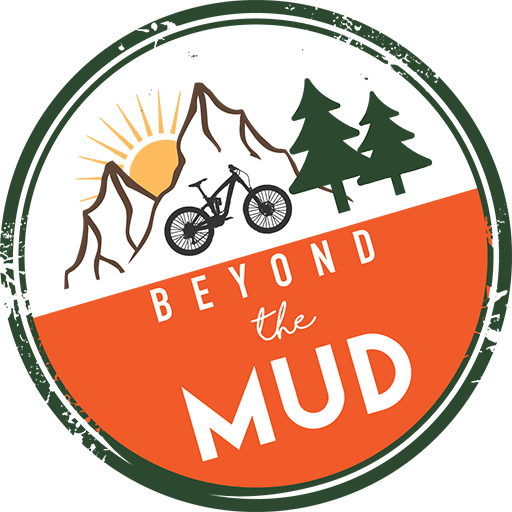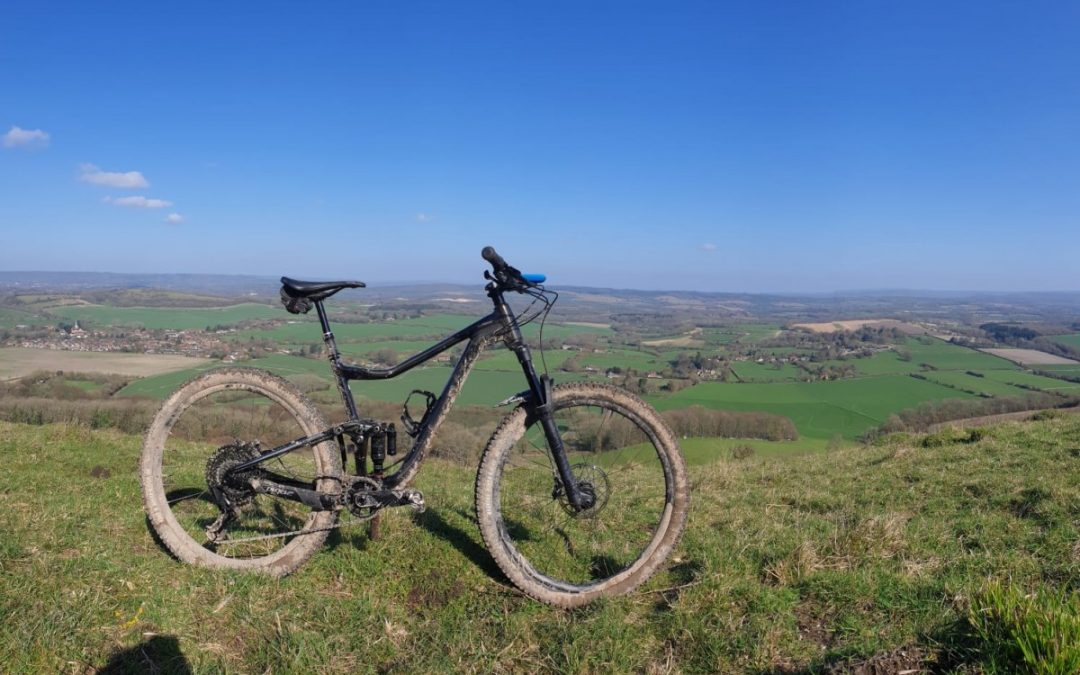
by hattenburrow | Apr 3, 2019 | Pilates, Training
If you want to be a ‘better’ cyclist you just put in ‘more miles’ right? Although to a certain extent yes, there are significant benefits to come from ‘off bike’ training such as Pilates.
Having a strong core can make it easier for you to climb and move around the bike. But many of us neglect our core muscles in favour of a few extra hours on the bike. A strong core can help revolutionise your cycling technique, whether you prefer skinny or fat tyre antics.

So, what is Pilates?
Pilates focuses on the ‘inner core’ of our bodies, developing strength from the innermost structures and works outwards. Rather than working our bodies through muscle isolation, Pilates focuses on posture, strength, mobility and flexibility from head to toe. Moving the body in complete flowing movements, not isolated parts.
Why is Pilates good for cyclists?
Besides the recognised benefits of taking time out to focus on you, in a calming and relaxing environment, it can actually improve your cycling form, efficiency and power. But how I hear you say?
Pilates:
- Develops a strong core and back for stable upper body.
- Builds cycling specific strength and muscle control.
- Increases flexibility and helps relieve tightness in cycling specific muscles.
- Reduces pain and discomfort from long stints in the saddle by building strength and stability in your muscles.
- Breath work helps to speed up recovery time as well as building focus and mental stillness needed for tackling trail features.
- Helps prevent and avoid injuries by creating an all-round more functional moving pattern.
- Increases balance by working on muscle control, this transfers to the bike, when you’re moving around the bike.
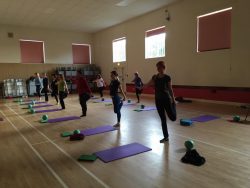
What some cyclists I work with have to say:
“As a cyclist I fall foul of not stretching, but with Pilates it gives my body a wakeup call, stretching to relieve tension, working on my core, but also giving that hour to unwind mentally. Try it!” – Matt
“Since doing Pilates, my posture on my bike has been much improved. I feel more stable and have less pressure on my hands. My breathing is more controlled and I’m very aware of my shoulders – I consciously try to keep them relaxed and down which relieves tension in my neck and through my arms, which in turn makes cycling more comfortable. ” – Karen
How often should you do it?
There’s not really a set rule to the regularity with which you should do Pilates. If you only have one hour a week, you will feel the benefits. Spend time working with a good instructor, try and get yourself into a small group, not a class of 30! Although you will still gain benefits from being in a bigger group, in a smaller group the instructor can give more hands on correction and support to you as a client helping you make the greatest gains. Most instructors will also help you with exercises you can do at home on your own as well. The stretches in a Pilates class especially can be done after any ride including hamstring and hip flexor stretch both excellent for cyclists!
What will a first Pilates session typically look and feel like?
The first thing to note about Pilates is there is a lot of information; don’t panic if you come away from your first session with brain fog that is normal. Pilates is about controlled movement patterns so expect to spend time finding and engaging your core muscles. Each movement should flow and you may feel the breathing and coordination seems a little strange, don’t worry after a few classes it will become clear. You should leave feeling relaxed, energised and like you have used muscles you never knew existed!
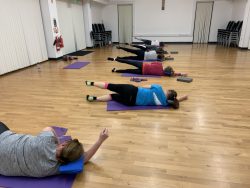
If you would like more information on my Pilates classes or to book a bespoke session for your cycling club please send me an email.
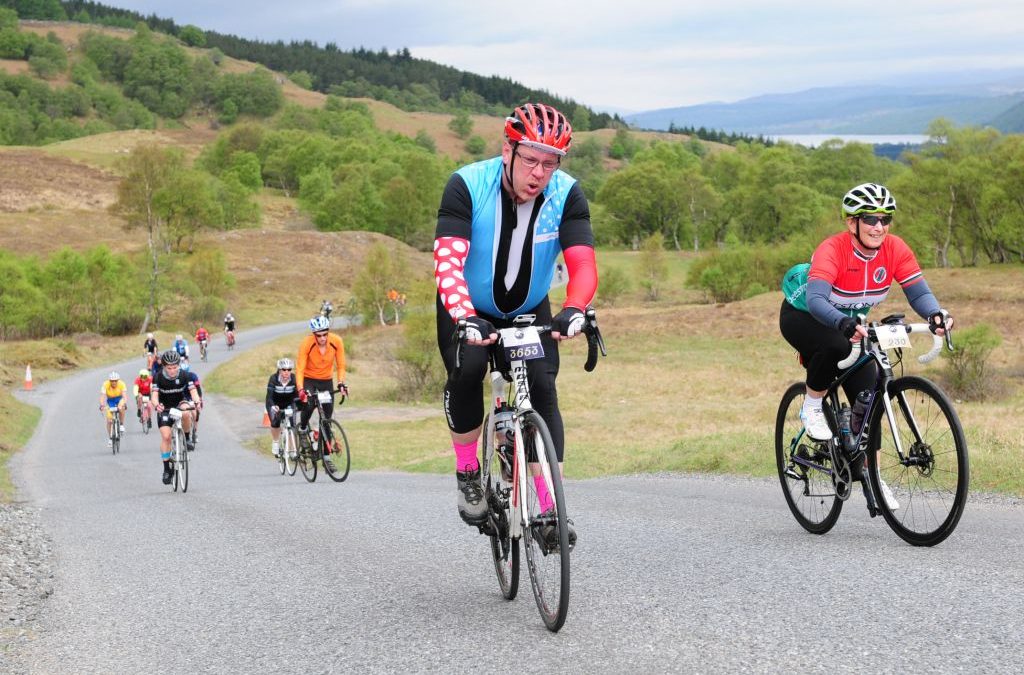
by hattenburrow | Jun 14, 2018 | Biking Adventures
Here is my latest guest blog from Ken.
I’m Ken, a librarian originally from Perth in Scotland but now living in Portsmouth. I played quite a few different sports as a child with rugby definitely being my favourite, and if my knees and ankles were a bit more robust I would still play. I’d had a road bike from my early teens so it was probably inevitable that I’d get back into cycling eventually. I got a new road bike in 2013 but didn’t really start riding regularly until the summer of 2014 when a picture of me with my youngest nephew made me realise just how much weight I’d put on. Since that time I’ve really been bitten by the bug to the extent that I’ve completed the London 2 Paris Sportive twice and in September 2018 am doing the Deloitte Ride Across Britain.
On May 20th I, along with 2700 others, took part in the Etape Caledonia a closed road sportive based in the lovely highland Perthshire town of Pitlochry. This was my 3rd time taking part and it was a relatively late decision to do so as initially the route wasn’t going to change so the challenge wasn’t quite there but when my Dad entered I decided that I’d go back and attempt to set my best time over the 81 miles.
After entering the organisers made some interesting changes to the route by adding in an extra 4 miles to the 81 miles. This was a new climb up towards Trinafour which added in around 1,000 feet of climbing and then a fun descent back down to Dunalastair Water to rejoin the route from the previous 2 years. With this climb added the route became much more of a training ride for the Deloitte Ride Across Britain in September and my goal changed from setting my best time to seeing how the legs recovered for the Schiehallion climb after a ride around Loch Rannoch.
Riding around the shores of Loch Rannoch was one of the highlights of the ride this year as it showed the camaraderie of the road brilliantly. Leaving the first feed station into a headwind I found myself being drafted by quite a few cyclists, I’m a relatively large chap with the characteristics of a diesel engine so act as a good wind break and tractor. After a mile what had been a bunch of complete strangers formed themselves into a cohesive group working together into the wind. This gave me a time of 1:00:14 for the timed Lord and Lady of the Loch section of the ride.
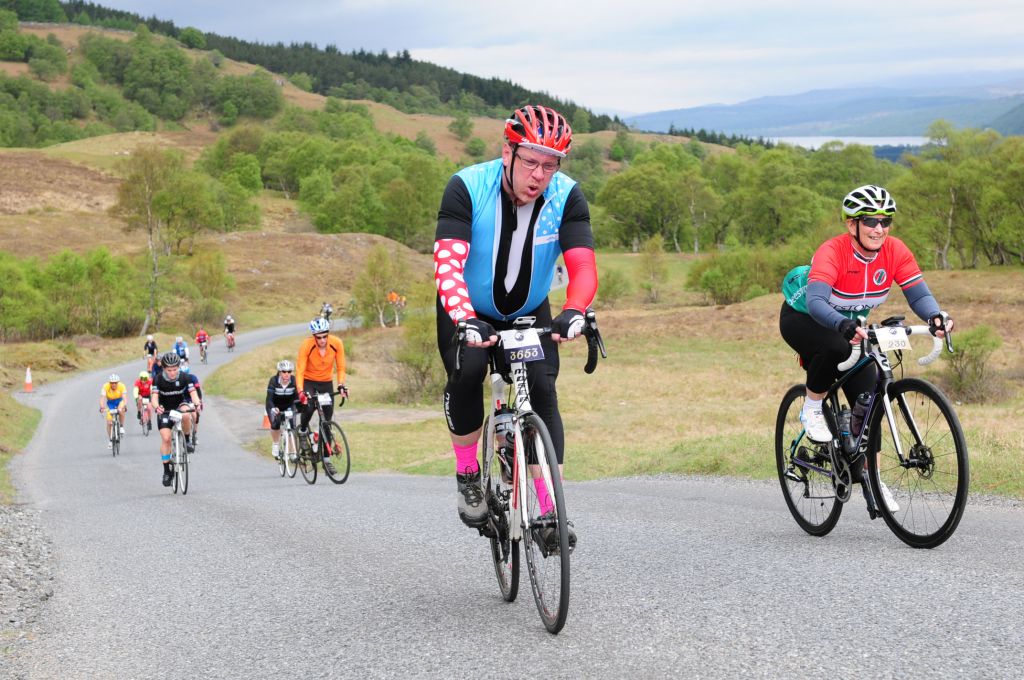
From the 2nd feed station on the south shore of Loch Rannoch your mind is focussed on the upcoming climb of Schiehallion, the signature climb, and the location of the timed King of the Mountain section. The timed section is 1.46 miles long with an average gradient of 6% but the full climb rolls over a plateau for almost 5 miles after that. My time on the timed section of the climb was 00:11:31 which was 35 seconds slower than 2017 showing the effect of the earlier climb.
What goes up must come down and this is where it being a closed road event is great because you can use the whole road on a descent which flows very nicely with only a couple of corners you have to be wary of, but these are well marked and well marshalled. Once off of the descent the rest of the ride is fairly flat and fast apart from the last 5 miles from Logierait to Pitlochry which has 3 steep, but thankfully short, sections in it.
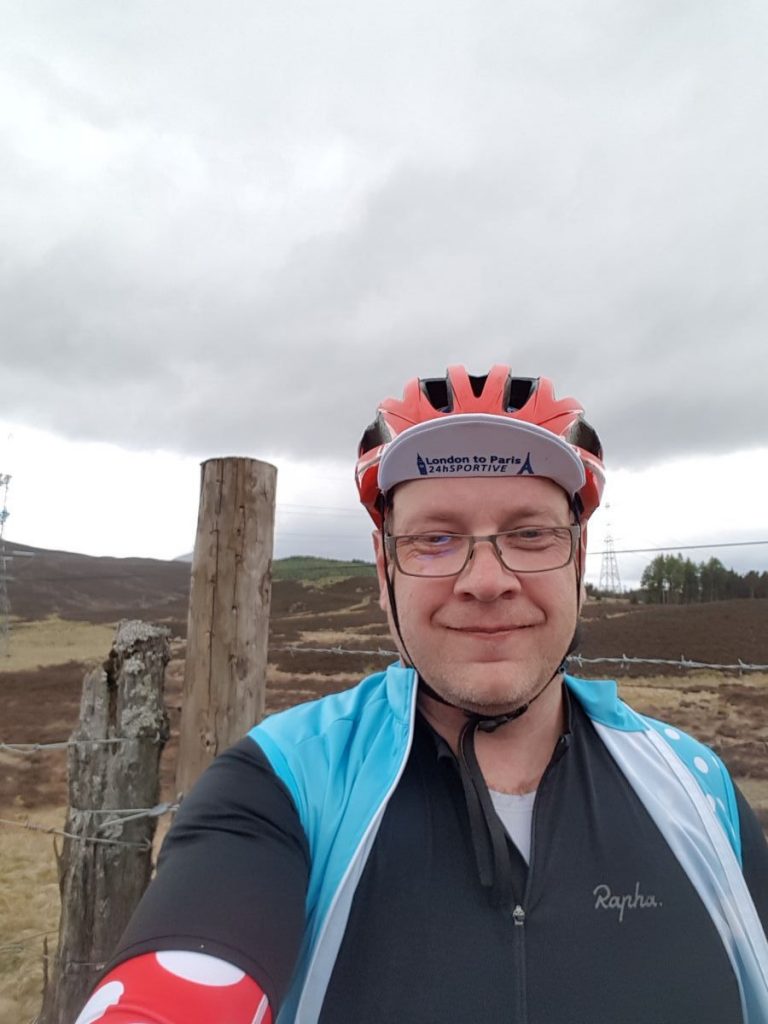
This is definitely a ride that I would recommend to anyone with an interest in cycling and one which is achievable by most people with some training. I am intending to do again in 2019 with the aim of beating my moving time of 05:18:24. If the thought of 85 miles is too much then the organisers added a 40 mile route option for 2018 and I hope that they do this again as it is a lot less daunting although it does include a different route up Schiehallion which I’ll have to find an excuse to do during the summer.

by hattenburrow | Feb 15, 2018 | Biking Adventures, Racing
Gravel races in Denmark
A couple of years ago, gravel cycling was totally unknown for Danish cyclists. It would be wrong to say, that every cyclist knows gravel cycling today, but almost every month a new gravel race pops up in my Facebook feed, that is already packed with pictures from gravel social rides. Gravel cycling is now booming in Denmark at the moment, and will only get bigger.
Gravel cycling in Denmark, is defined by the social element, together with the adventure part. There are of course riders in front of every race, that are competing to win the races, but believe that for most Danish gravel cyclists it’s about experiencing new routes, in new areas together with like-minded cycling friends.

I have personally participated in a couple of these gravel races, and Hansens Cykelløb is be far my favourite. I participated in the second edition in 2017 together with my colleagues from GripGrab. A 130km long gravel race in the Danish countryside of Northern Zealand. The race is arranged by the Danish ice cream brand Hansen, why the three feed stations where well equipped with the best ice cream you can dream of, and of course good coffee and sandwiches. Not the best fuelling for riding on the AT threshold, but perfect fuelling for a cozy ride with your friends. Exactly how I like it! I’ll be back for more ice cream and gravels in 2018.

Read Tim Wiggin’s, from Wiggle, race report from Hansens Cykelløb at:
https://www.lifeinthesaddle.cc/2017/08/the-‐hansens-‐cykellb-‐ice-‐cream-‐gravel.html

by hattenburrow | Feb 9, 2018 | Adventure, Biking Adventures, Inspiration
In some countries the bike is only for those who don’t have a car. In Denmark, the bike is a symbol of freedom, health and effectiveness. The Danes loves to cycle and embraces all that it implies. Now the Danes have fallen in love with Gravel Cycling.
By Peter Ebro, GripGrab
Denmark, a Cycling Nation
Denmark is renowned worldwide for its biking culture. The Norwegians are raised with cross-country skies on their feet, while Danes are raised with bikes. Everybody in Denmark knows how to ride a bike, and almost 50% of all Danes jump on to their bike several times a week.
Our infrastructure is designed with cyclist’s in mind, and only very few roads don’t having a cycling path running parallel with it. An infrastructure that cities around the world are copying – in New York they even call the cycle paths for Copenhagen Lanes!
Denmark really is biking heaven for cyclists.
What is Gravel Cycling?
Gravel cycling is booming at the moment all over the world. But what is gravel cycling actually? And why?

Photo by Martin Paldan | GripGrab Media Crew
Gravel cycling is, as the name suggests, cycling on gravel or dirt roads. You can ride whatever bike you want to, but the experience is optimised on a gravel bike. Gravel bikes look very similar to a road bike, just with a few, but important differences, that makes the bike more suitable for riding on rough surfaces for long distances; wider tires with more grip, to make the ride more comfortable, disc brakes for optimal braking power, and longer wheel base and a taller head tube for a more stable and comfortable ride.
Gravel Cycling in Denmark
Actually, we Danes have always practised gravel cycling – just without calling it by its trending name. We have for decades cycled in our many forest, not on a gravel bike, as we know it today, but on mountain bikes or for a minority of people on cyclocross bikes.

We don’t have endless forests like they have in Sweden. We don’t have any high mountains like in the Alps. But we do have a lot of diverse natural areas spread out around our little country; flat and windblown moors in Jutland, hilly beech forests, spruce plantations and a countless number of fields – all embraced by a beautiful shoreline all the way around our little kingdom.
The majority of the Danish forests are owned by the state, which means, that they are being maintained by the state, so that they are always passable with good and well paved gravel roads. The forests are always open to the public -‐ even at night as long as you show consideration to the animals. Furthermore, big areas are preserved as national parks that work like huge natural museums, that you can experience on your bike.

For gravel riders, it is a sport in itself to plan the optimal gravel routes, where as many of the natural areas are linked together with gravel roads and a minimum of paved tarmac. These routes are frequently shared on online forums and basis for many social rides, where locals are guiding foreigners around.
We Danes envy the Alpine countries, but appreciate what we have. And I love what we have.

What’s in it for me?
Adventures are the key for me. I have been running for many years. I started out participating in a bit of adventure racing, mountain biking, marathon running and then I got the trail running bug. I fell totally in love with the feeling of being alone with nature, running by myself through forests and fields. If I got a little lost – it made me feel like, I was on an adventure. So, I searched the unknown, both in distance and in new places.
My small everyday adventures got fuelled by dreams of bigger adventures and longer runs in the Alps and Pyrenees, where I participated in several ultra runs and stage races. The racing itself was not a motivation for me, it’s the adventure of the race that drives me. And that is exactly what I get every time I clip into my pedals, and head into the forest towards uncharted lands, where new adventures are waiting to be discovered.
For me, a long ride for a couple of hours on the gravel bike is now my go to two-wheeled machine. Not because I don’t like the fast feeling of a road bike, or the rush from a nice flow trail, but it can’t match the feeling of freedom I’m exposed to, when I swing away from the asphalt and into the forest. Here there is no traffic, that disrupts my ride, it’s just me and the natural environment alone all year round.

A gravel bike is so versatile, that I can use it for my weekend adventures in northern Zealand, but also for my daily commutes to work. I can go anywhere (almost) on my gravel bike, and I can go there fast and feeling comfortable.
My gravel bike is my two-‐wheeled adventure vehicle. And Denmark is still packed with undiscovered territories, that I have to explore. I’m off – see you on the gravel roads!
Denmark North + South f&b + cycling paths (+r)

by hattenburrow | Nov 28, 2017 | Adventure, Biking Adventures, How to
Winter riding doesn’t have to be a frosty affair it can be good fun and very beautiful especially if you are prepared.
“If you fail to prepare, you prepare to fail”
My advice would be look at what rides / training you want / need to do then head to trusty (or not so) BBC weather forecast and look at the week ahead this will help you plan longer rides on days when the weather is better and shorter sessions in the rain.
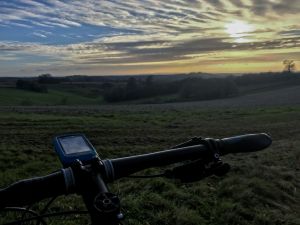
One thing to mention on this is that if you’re doing sprints, wet / icy weather and slippery roads are not a good combo so be ready to change your session accordingly if you can be flexible in your training around the weather and expect that, it will rain, you will get wet and it may be cold for the first 5 minutes until you warm up then riding will be enjoyable.
It is true what they say there is never the wrong weather just the wrong gear.
My top kit list would be:
- Grip Grab overshoes – warm and dry feet make riding in wet and cold weather so much more comfortable. Make sure you buy a size that hugs your shoes I recommend The Hammerhead, it is a warm and waterproof coated neoprene winter shoe cover. Designed and tested to keep your feet warm and dry in wet and cold weather conditions.
- Altura Night Vision Evo jacket this versatile jacket is labelled for ‘commuting’ however I love mine for every occasion it’s great for training the big vents on the sides give adequate breathability whilst knowing I have the waterproof and high visibility factors Altura say: The Night Vision Evo features lightweight, waterproof, windproof and breathable fabrics in a soft touch 2 Layer Altura Shield™ EVO fabric, which help to keep you both dry and warm on your rides. You then have the benefit of critically positioned reflective details and an ingenious integrated i-Lume™ rear flashing light to ensure you are easily seen. With the addition of NV360° performance you have 360 degrees of reflectivity for maximum after dark visibility from all angles.
- The cloudburst glove from Grip Grab is waterproof and windproof glove, like slipping your hands into hot water bottle covers whilst you ride with a soft fleece lining. The OutDry® Waterproof and Breathable membrane makes the Cloudburst gloves that will serve you well as an all-round high-end glove.

Riding through winter tips:
- Early mornings are stunning wake up and get out before the sun rises and watch it come up also a bonus around Christmas is seeing everyone’s Christmas lights!
- Put a little warm water in your bottles if riding in freezing conditions to stop it freezing.
- Get your kit on the radiator ready to go!
- Check your tyre pressure riding in a lot of mud – decrease the air in your tyres to help with grip
- Get a good pair of lights, ideally helmet and handle bar Exposure lights are fantastic but pricey for a cheaper option search amazing from 1000 lumen lights
- Invest in thermal underwear and a good rain / windproof
- Let people know where you’re going and how long you will be out





